Ruschia
Ruschia promontorii L.Bolus
Family:
Common names: Peninsula cliff ruschia (Eng.); Skiereiland-kransvygie (Afr.)
Plant Attributes:
Plant Type:
SA Distribution:
Soil type:
Flowering season:
PH:
Flower colour:
Aspect:
Gardening skill:
Special Features:
Horticultural zones
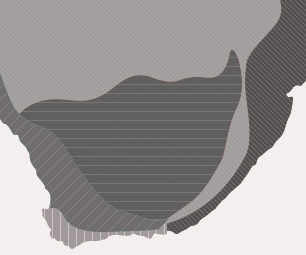
Ruschia spinosa (L.) Dehn. (= Eberlanzia spinosa (L.) Schwantes)
Family:
Common names: thorny vygie, spiny ruschia (Eng.); doringvygie (Afr.)
Plant Attributes:
Plant Type:
SA Distribution:
Soil type:
Flowering season:
PH:
Flower colour:
Aspect:
Gardening skill:
Special Features:
Horticultural zones

Ruschia maxima (Haw.) L.Bolus
Family:
Common names: giant mountain vygie (Eng.)
Plant Attributes:
Plant Type:
SA Distribution:
Soil type:
Flowering season:
PH:
Flower colour:
Aspect:
Gardening skill:
Special Features:
Horticultural zones

Ruschia Schwantes
Family:
Common names: beesvygie (Afr.)
Species
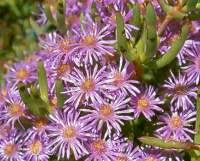
Ruschia viridifolia has very green leaves and reaches up to 0.6 m. The flowers are pink and appear from summer to autumn. They are ideal filler plants between rocks in sunny positions.
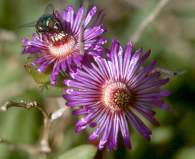
R. caroli is a fast-growing plant up to 0.5 m high with a somewhat spreading habit. The flowers are pink and appear in masses from spring. This species occurs in succulent karoo regions from Clanwilliam to the Little Karoo and is better suited as mass plantings for larger areas.
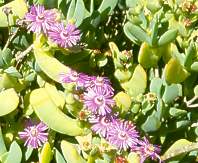
R. maxima and R. strubeniae have large, succulent leaves and medium-sized pink to purple flowers which appear from autumn to spring. They reach up to 1.5 m high and should be planted in combination with other, bigger plants such as Crassula, Cotyledon, Senecio and Aloe. R. maxima is from dry fynbos areas near Graafwater in the Western Cape and is a species that does very well in cultivation. R. strubeniae is a dry fynbos and renosterveld species occurring from Piketberg.
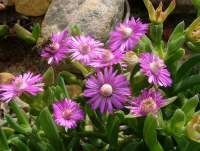
R. langebaanensis is a pink ground cover species which is well adapted to sandy and coastal conditions and is found in Langebaan, a coastal town on the west coast of the Cape. The species is ideal for stabilising difficult sandy places such as dunes, and can be used in combination with R. caroli.

R. radicans is another species from the west coast, Northern Cape and Namaqualand. It roots easily at its nodes and covers the ground very fast. This species is ideal for terraces, retaining walls and embankments, as it cascades beautifully on angled surfaces. The pink flowers are 13 mm in diameter and appear in spring.

R. lineolata (lineolata means bearing small lines, and refers to the distinctly striped perianth segments), is a procumbent plant forming matted cushions of 0.6 m in diameter. Flowers are purple and 20 mm in diameter. This very attractive species grows on shale ridges of dry streambeds in the renosterveld and succulent karoo. It occurs south of the Langeberg, Robertson and Barrydale Districts.

R. acuminata is a stout shrublet up to 0.3 m high, with erect, floral branches. White to pale pink flowers of about 20 mm across appear in masses from December. It grows on the northern slopes of the Langeberg at the entrance to Robinson Pass in the Little Karoo.

R. centrocapsula is a dwarf, spiny shrublet up to 0.2 m high, with purplish pink flowers which appear in spring. This plant is ideal for very rocky and extremely arid gardens. It occurs in Bushmanland in the Northern Cape.
R. cradockensis subsp. triticiformis is widely distributed from the Eastern Cape to the Sutherland District in the west. It is a very hardy plant up to 0.3 m tall, spiny and rounded with pink flowers in the winter.

R. karooica is an erect plant with stiff stems up to 0.3 m tall. Flowers are large, up to 50 mm across, purplish pink, and appear in August to September. It is found near Matjiesfontein in the southern Great Karoo.

R. knysnana, named after the town of Knysna, is a rigid shrub reaching 0.4 m tall. Flowers are bright reddish pink and 25 mm in diameter, appearing in spring.
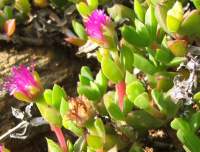
R. promontorii is a Cape endemic only known from Cape Point in the Cape Peninsula National Park where it grows abundantly. It is a procumbent (flat or prostrate growing) species that readily roots at the nodes. The stems can reach 0.3 to 0.4 m long. Its flowers are pink-purple in midwinter. This species is another excellent choice for rocky gardens along the Cape Peninsula.

Ruschia spinosa. The spinescent shrublet R. spinosa reaches 0.3 m tall and occurs near Matjiesfontein in the southern Great Karoo. Flowers are smallish, rose pink, and appear in spring. This is another species that is well adapted to very harsh conditions.
Plant Attributes:
Plant Type:
SA Distribution:
Soil type:
Flowering season:
PH:
Flower colour:
Aspect:
Gardening skill:
Special Features:
Horticultural zones






Rate this article
Article well written and informative
Rate this plant
Is this an interesting plant?
Login to add your Comment
Back to topNot registered yet? Click here to register.